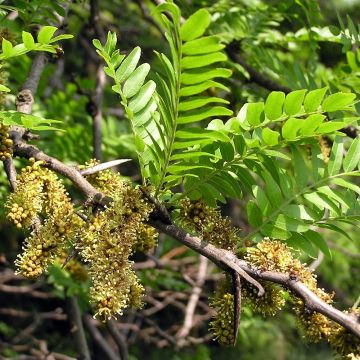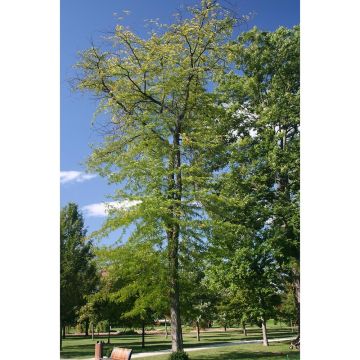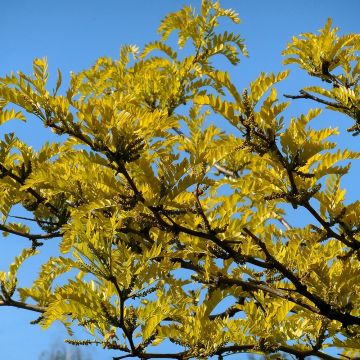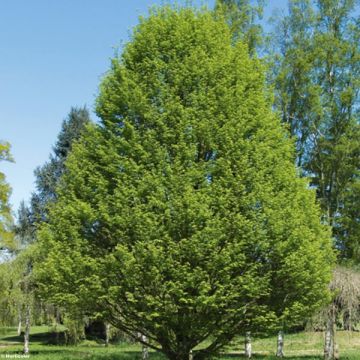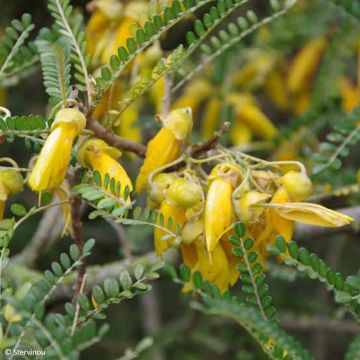

Gleditsia x texana - Texas Honey Locust
Gleditsia x texana - Texas Honey Locust
Gleditsia x texana
Texas Honey Locust, Thornless Honey Locust
Why not try an alternative variety in stock?
View all →This plant carries a 24 months recovery warranty
More information
We guarantee the quality of our plants for a full growing cycle, and will replace at our expense any plant that fails to recover under normal climatic and planting conditions.
From €5.90 for pickup delivery and €6.90 for home delivery
Express home delivery from €8.90.
Does this plant fit my garden?
Set up your Plantfit profile →
Description
Gleditsia x texana, commonly known as the hybrid American honey locust, is a deciduous tree of beautiful stature, with few thorns, interesting for its light branches. It stands out for its elegant, light, finely cut foliage and beautiful autumn colouration. Tolerant of different types of soil and perfectly resistant to cold, this honey locust adapts to many climates. It is suitable for parks and large gardens.
Gleditsia x texana belongs to the Fabaceae family. This natural hybrid is the result of cross-breeding between Gleditsia triacanthos and G. aquatica. Originally from lowlands near Brazoria, Texas, it was first observed in 1892 and introduced into cultivation in 1900. It grows at a medium pace and reaches a minimum height of 12 m with a spread of 4 to 6 m. This tree has an upright habit, a few scattered thorns on the branches and trunk, and thornless leaves, unlike those of the Gleditsia triacanthos. Its bark is smooth and pale. Its leaves, 10 to 20 cm long, are composed of 6 to 16 pairs of small oblong to oval leaflets, a shiny dark green in summer. In autumn, they take on shades ranging from yellow to orange and red before falling. The flowers of the hybrid American honey locust, grouped in clusters of 7 to 10 cm, are dark yellow-orange. Its fruits are flat pods measuring 10 to 13 cm long, dark brown and devoid of pulp. They contain several small seeds. This hybrid adapts to different types of soils, including sandy, loamy, and clay soils.
Gleditsia x texana is a versatile tree that can be used in various landscaping projects. It is interesting for creating a focal point in large gardens and parks. It can be paired with Cercis canadensis 'Red Force' (Eastern Redbud), with its pink spring flowers and purple foliage, Quercus palustris (Pin Oak), which brings its robust structure to the ensemble, Acer rubrum 'Armstrong Gold' (Red Maple), for its flamboyant autumn colours, and Liquidambar styraciflua 'Rotundiloba' (American Sweetgum) with its beautiful palmate leaves that are highly coloured in autumn.
Report an error about the product description
Plant habit
Flowering
Foliage
Botanical data
Gleditsia
x texana
Fabaceae
Texas Honey Locust, Thornless Honey Locust
North America
Other Gleditsia - Honey Locust
Planting and care
Gleditsia x texana prefers a very sunny location and rich, well-drained soil. Windy areas should be avoided as the wood is quite fragile. Make a deep planting hole for it, mixing compost with your garden soil for organic matter and coarse sand if needed to lighten heavy soils like clay. Pruning is limited to the removal of dead branches; it does not require training pruning, as its trunk is naturally well cleared.
Planting period
Intended location
Care
This item has not been reviewed yet - be the first to leave a review about it.
Striking foliage shrubs
Haven't found what you were looking for?
Hardiness is the lowest winter temperature a plant can endure without suffering serious damage or even dying. However, hardiness is affected by location (a sheltered area, such as a patio), protection (winter cover) and soil type (hardiness is improved by well-drained soil).

Photo Sharing Terms & Conditions
In order to encourage gardeners to interact and share their experiences, Promesse de fleurs offers various media enabling content to be uploaded onto its Site - in particular via the ‘Photo sharing’ module.
The User agrees to refrain from:
- Posting any content that is illegal, prejudicial, insulting, racist, inciteful to hatred, revisionist, contrary to public decency, that infringes on privacy or on the privacy rights of third parties, in particular the publicity rights of persons and goods, intellectual property rights, or the right to privacy.
- Submitting content on behalf of a third party;
- Impersonate the identity of a third party and/or publish any personal information about a third party;
In general, the User undertakes to refrain from any unethical behaviour.
All Content (in particular text, comments, files, images, photos, videos, creative works, etc.), which may be subject to property or intellectual property rights, image or other private rights, shall remain the property of the User, subject to the limited rights granted by the terms of the licence granted by Promesse de fleurs as stated below. Users are at liberty to publish or not to publish such Content on the Site, notably via the ‘Photo Sharing’ facility, and accept that this Content shall be made public and freely accessible, notably on the Internet.
Users further acknowledge, undertake to have ,and guarantee that they hold all necessary rights and permissions to publish such material on the Site, in particular with regard to the legislation in force pertaining to any privacy, property, intellectual property, image, or contractual rights, or rights of any other nature. By publishing such Content on the Site, Users acknowledge accepting full liability as publishers of the Content within the meaning of the law, and grant Promesse de fleurs, free of charge, an inclusive, worldwide licence for the said Content for the entire duration of its publication, including all reproduction, representation, up/downloading, displaying, performing, transmission, and storage rights.
Users also grant permission for their name to be linked to the Content and accept that this link may not always be made available.
By engaging in posting material, Users consent to their Content becoming automatically accessible on the Internet, in particular on other sites and/or blogs and/or web pages of the Promesse de fleurs site, including in particular social pages and the Promesse de fleurs catalogue.
Users may secure the removal of entrusted content free of charge by issuing a simple request via our contact form.
The flowering period indicated on our website applies to countries and regions located in USDA zone 8 (France, the United Kingdom, Ireland, the Netherlands, etc.)
It will vary according to where you live:
- In zones 9 to 10 (Italy, Spain, Greece, etc.), flowering will occur about 2 to 4 weeks earlier.
- In zones 6 to 7 (Germany, Poland, Slovenia, and lower mountainous regions), flowering will be delayed by 2 to 3 weeks.
- In zone 5 (Central Europe, Scandinavia), blooming will be delayed by 3 to 5 weeks.
In temperate climates, pruning of spring-flowering shrubs (forsythia, spireas, etc.) should be done just after flowering.
Pruning of summer-flowering shrubs (Indian Lilac, Perovskia, etc.) can be done in winter or spring.
In cold regions as well as with frost-sensitive plants, avoid pruning too early when severe frosts may still occur.
The planting period indicated on our website applies to countries and regions located in USDA zone 8 (France, United Kingdom, Ireland, Netherlands).
It will vary according to where you live:
- In Mediterranean zones (Marseille, Madrid, Milan, etc.), autumn and winter are the best planting periods.
- In continental zones (Strasbourg, Munich, Vienna, etc.), delay planting by 2 to 3 weeks in spring and bring it forward by 2 to 4 weeks in autumn.
- In mountainous regions (the Alps, Pyrenees, Carpathians, etc.), it is best to plant in late spring (May-June) or late summer (August-September).
The harvesting period indicated on our website applies to countries and regions in USDA zone 8 (France, England, Ireland, the Netherlands).
In colder areas (Scandinavia, Poland, Austria...) fruit and vegetable harvests are likely to be delayed by 3-4 weeks.
In warmer areas (Italy, Spain, Greece, etc.), harvesting will probably take place earlier, depending on weather conditions.
The sowing periods indicated on our website apply to countries and regions within USDA Zone 8 (France, UK, Ireland, Netherlands).
In colder areas (Scandinavia, Poland, Austria...), delay any outdoor sowing by 3-4 weeks, or sow under glass.
In warmer climes (Italy, Spain, Greece, etc.), bring outdoor sowing forward by a few weeks.


































